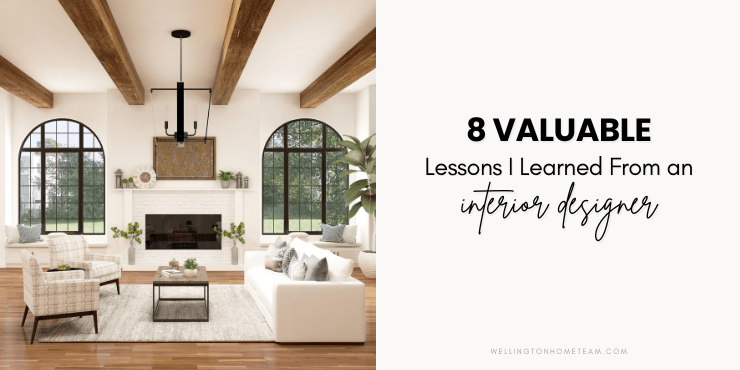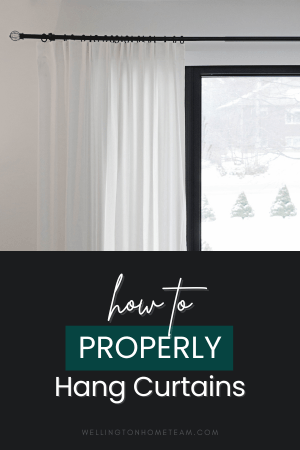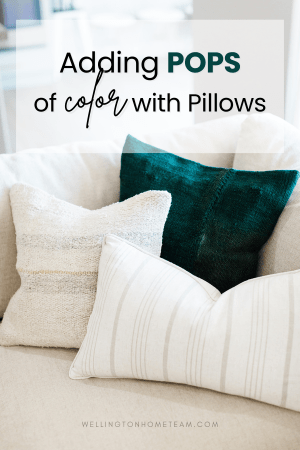8 Valuable Lessons I Learned From an Interior Designer
Have you ever walked into a beautifully designed room and wondered what makes it look so effortlessly elegant? I recently had the opportunity to work with a professional interior designer, and I was amazed at how much I learned about creating a well-designed living space.

In this article, I’ll share some valuable insights that I gained from my experience of working with a professional interior designer.
What an Interior Designer Taught Me
1. Rug Size Matters
One of the first things I learned was that the size of a rug can make a significant difference in the overall look and feel of a room. A rug should be large enough to anchor the furniture in the seating area. It should extend under the front legs of sofas and chairs, creating a cohesive and visually appealing grouping.
 2. Curtain and Rods Matter
2. Curtain and Rods Matter
Curtains and curtain rods play a crucial role in framing windows and enhancing the overall aesthetic of a room. To create an illusion of height and space, hang curtains at least 6 inches above the window frame.
The curtain rod should also extend past the window frame so that when the drapes are open they flank the window, they don’t cover it. Make sure to choose curtain rods that complement the style of the room and ensure that the curtains reach the floor for a clean look.
3. TV and Art Placement On a Wall Matter
When it comes to arranging a television and art on the walls, placement is key. Consider the viewing angle from various seating areas when positioning the TV. If a TV is hung on the wall there are additional considerations that need to be made. If a TV is hung too high it could look like it’s floating and if it’s too low it may be tough to view.
The height at which artwork should be hung can vary depending on factors like the size of the artwork, the height of the ceiling, and personal preferences. However, in most cases, artwork should be hung at eye level, which is approximately 57 to 60 inches (145 to 152 centimeters) from the floor to the center of the artwork. This guideline is based on the average eye level of a person standing, and it ensures that the artwork is easily visible and can be appreciated without straining the neck.
4. Direction of Plank Flooring Matters
If you have plank flooring in your home, pay attention to the direction in which the planks are laid. A professional interior designer taught me that the direction of the planks can impact the perception of space. Planks laid perpendicular to the main entrance can make a room appear wider, while planks laid parallel can make it seem longer. However, it ultimately depends on the size of the planks and the room itself.
What an Interior Designer Taught Me (Continued)
5. Avoid Matchy-Matchy Items
Gone are the days of perfectly matched furniture sets. A professional interior designer advised me to embrace diversity and mix different styles, colors, and materials. Combining contrasting elements can create a more dynamic and visually interesting space. Instead of having a matching bedframe, nightstands, and dresser switch out the bedframe for a fabric one. Additionally, consider the shape of furniture along with the types of legs they have. All of the furniture in a room shouldn’t be rectangular and have legs, switch it up!
 6. Keep It Neutral
6. Keep It Neutral
A fundamental principle of interior design is to keep major furniture pieces, walls, and window treatments neutral. Neutral colors provide a timeless backdrop that allows for flexibility in decorating.
Inject pops of color and personality with accessories like artwork, throw pillows, and blankets, which can be easily swapped out to refresh the room’s look.
7. Less Is More
The mantra “less is more” is a guiding principle in interior design. Avoid overcrowding a room with excessive furniture or home decor items. Not every wall needs artwork nor does every surface need something on it. A clutter-free space not only looks more appealing but also promotes a sense of tranquility and organization.
8. Add Plants
I also learned how to breathe life into my spaces by bringing in plants or greenery, whether real or fake. The inclusion of plants or even stems adds a refreshing touch of nature, infusing vitality, and tranquility into any room.
Final Thoughts
Working with a professional interior designer opened my eyes to the art and science of creating beautiful and functional living spaces. These valuable lessons have changed the way I approach interior design. By applying these principles, you can elevate the aesthetics of your home and create a more inviting and harmonious environment.
Please consider spreading the word and sharing; 8 Valuable Lessons I Learned From an Interior Designer
Discover the invaluable lessons learned from a seasoned interior designer. Explore 7 expert insights to elevate your home's style and functionality. #homedecor #interiordesignAbout the Author
Top Wellington Realtor, Michelle Gibson, wrote: “8 Valuable Lessons I Learned From an Interior Designer”
Michelle has been specializing in residential real estate since 2001 throughout Wellington, Florida, and the surrounding area. Whether you’re looking to buy, sell, or rent she will guide you through the entire real estate transaction. If you’re ready to put Michelle’s knowledge and expertise to work for you, call or e-mail her today.
Areas of service include Wellington, Lake Worth, Royal Palm Beach, Boynton Beach, West Palm Beach, Loxahatchee, Greenacres, and more.

 Michelle Gibson of the Hansen Real Estate Group Inc is a full-time REALTOR who has been specializing in Wellington, Florida real estate since 2001. This veteran of the real estate industry has expertise in technology, marketing, and social media.
Michelle Gibson of the Hansen Real Estate Group Inc is a full-time REALTOR who has been specializing in Wellington, Florida real estate since 2001. This veteran of the real estate industry has expertise in technology, marketing, and social media.